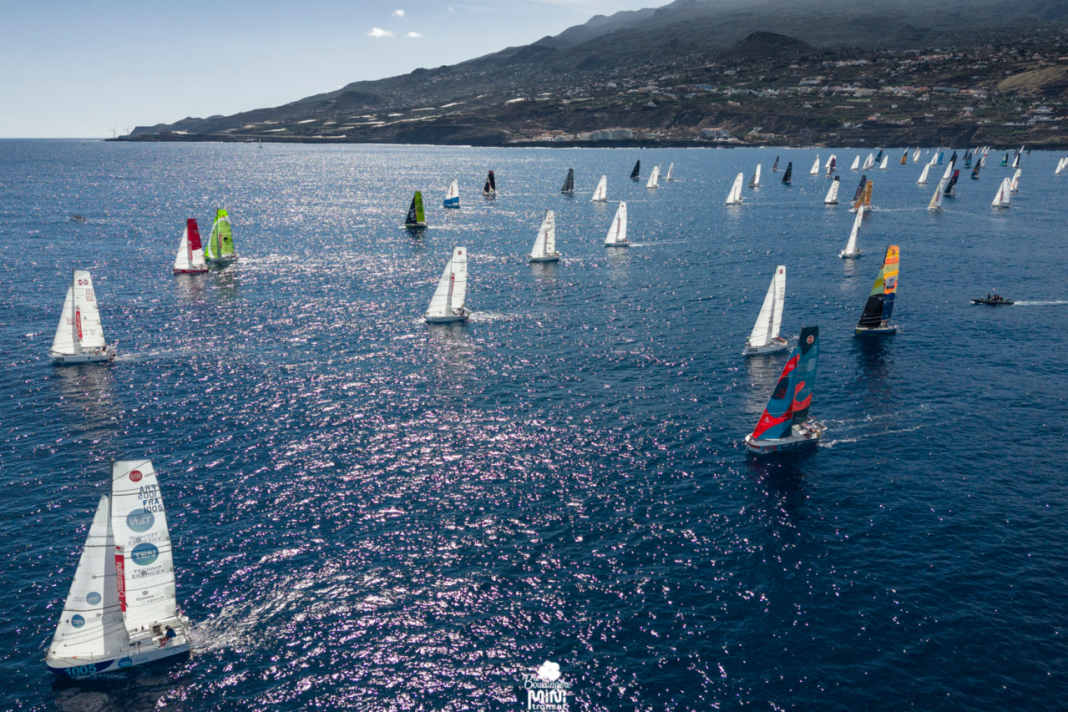Mini-Transat: The royal stage is underway - 89 mini-soloists in Atlantic fever
Tatjana Pokorny
· 25.10.2025






The starting signal for the second leg of the La Boulangère Mini Transat was given on Saturday afternoon at 4pm German time off Santa Cruz de La Palma. It was the expected light wind start under a bright blue sky. The few knots of pressure were just enough to push the Minis along the 2700 nautical mile course to Saint-François on Guadeloupe.
Mini-Transat: The "Superfoiler" leads even without wind
In the prototypes, favourite Benoît Marie ("Nicomatic - Petit Bateau") was unimpressed by the flat conditions right from the start: The "Superfoiler" took the lead straight away and, after a few small losses, held on to it again late on Saturday evening. Around 11 p.m., Alexandre Demange ("DMG Mori Sailing Academy 2") and Julien Letissier ("Frerots Branchet") were the first to take the lead behind him.
At this early stage, however, only around 13 nautical miles separated the entire prototype fleet of 32 boats that had started. With persistent light winds, constant and significant shifts in position were to be expected for the first 24 to 48 hours. Click here for the mini-transat tracker.
In the series boats, it was Düsseldorf's Hendrik Lenz who got off the line best. This was reported by the French organisers. After his "worst start ever" on leg one, where he had raced up to third place before the race was cancelled, the "Monoka" skipper showed the opposite at the start of leg two. He had planned a safe start, as early starters were threatened with a draconian 24-hour penalty.
Competitive pushing in flat mini-transat winds
However, the larger field of 57 series boat sailors was even closer together in three or four knots of wind after the first few hours from the first to the last skipper. Only seven and a half nautical miles separated the leader Paul Cousin ("AFP - Biocombustibles") and the last-placed Miguel Angel Rondon Gonzales ("Kristina II") in the late evening of 25 October.
The mini-sailors from Santa Cruz de La Palma pushed southwards in close succession. Hendrik Lenz had fallen back to 16th place in the meantime, but had moved up to ninth place again. The ups and downs continued for most of the sailors in the Mini-Transat wind lottery into the night, with the favourites making good progress. The Atlantic challengers knew in advance what a battle of nerves they would face at the start of the Atlantic leg. Click here for a preview of the stage.
Saturday's start in the Mini-Transat brought the three-week stopover on the Canary Island of La Palma to a close. Here, the Miniists had been working on repairs, but also enjoying each other's company on excursions lasting several days and evenings out together. "This class is like one big family, it's pretty incredible. We have a very strong bond and a real brotherhood among us," Matthieu Faivre ("La Fabuleuse Armada") happily noted before leaving.
Marie Chaussade ("Ganesh"), who set off on the XL Atlantic adventure with 88 friends, had the same feeling: "We've been preparing for two and a half years and now the time has come. It's a very joyful feeling." For the majority of the mini-sailors, this second leg across the Atlantic is the culmination of several years of endeavour. "After four years of dreaming and two years of preparation, I'm finally here," explained Naho Takahara ("Seven X Seven"), visibly moved as he cast off.
The mini-transat: "an incredible stage of life"
Julien Matha ("X-FLR6") showed the same emotion: "It all started with a friend. She told me: 'You have to live your dreams', and that was the starting signal. This mini-project has become ten thousand times more important in my life than I expected, but it's an incredible stage in my life. " For Hendrik Lenz from Düsseldorf, it was his former Opti training buddy Lina Rixgens, whose Mini-Transat endeavours inspired him to take on a Mini-Transat start himself.
Many predicted before the start that it could take 24 to 48 hours for the Minis to reach the increasing trade winds on their course to the Antilles. Until then, good nerves are required. And perhaps less sleep than the calm conditions suggest. "You can win a lot in this phase, but you can also lose a lot. It will depend a lot on how you sail at night. If you miss a breeze, it's bad," knew Hendrik Lenz even before the starting signal.
Like his Franco-German training group colleague Victor David, the best German player in the Mini-Transat, which has been held since 1977, at the end of leg one, predicted a leg duration of around 16 or 17 days. All skippers have to reckon with the race organisers adding another waypoint to the one that has already been drawn in. If this happens, it will only be between the start and the waypoint already positioned around 150 nautical miles from the start line.
The Atlantic is the playing field in the mini-transat
In this way, the race committee wants to keep open the possibility of being able to react to a possible approaching Jamaican low or even a hurricane. Another change was also announced in the skipper's briefing: Mini-Transat sailors are not required to wear a lifejacket, but must alternatively be tethered with a lifebelt. Thus protected, over the next two and a half weeks the Atlantic will be their playing field, their horizon and for many the symbol of a dream realised.

